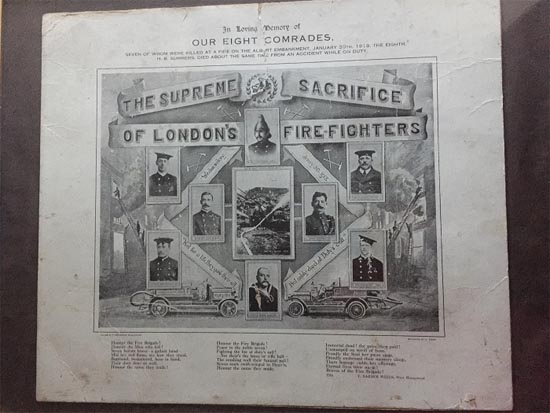The Brigade is holding a memorial event today to mark the 100 year anniversary of a fire in Lambeth that resulted in seven firefighters losing their lives. The tragedy remains the greatest single loss of London firefighters during peacetime.
The fire, which broke out in the early hours of the morning at a cattle food manufacturers on Albert Embankment, is remembered as one of the darkest incidents in the history of the Brigade. Whilst not a particularly big blaze, conditions were difficult due to dense fog and heavy smoke. The poor conditions forced the men to wear helmets, which reduced their visibility and meant they couldn’t see as an outer wall collapsed on top of them.
Two sub-officers and five ‘firemen’* lost their lives, with several others being injured. Those who lost their lives were: Sub Officer William Cornford, Sub Officer Walter Hall, Fireman John Coote Johnson, Fireman Arthur Page, Fireman Edmund Fairbrother, Fireman William Nash, and Fireman James Fay, who just one week before the fire had returned from active service during the First World War.

Today’s memorial event is being held at 8 Albert Embankment, which is the site of the fire and the place which went on to become the Brigade’s headquarters from 1937-2008. Today, the Brigade’s pop-up museum is situated in the Brigade’s former workshops nearby, whilst plans for a permanent museum on the site are finalised.
Two of the great-grandchildren of two of the men that died will be present at the event.
The Brigade’s Director of Operations, Tom George, said:
“I feel humbled to be able attend this ceremony and pay my respects to the seven men who lost their lives whilst selflessly battling to put out this fire one hundred years ago. They represent a long line of brave and remarkable firefighters who to this day continue to put themselves in the line of danger to protect others.
“This tragic fire will always be remembered by the Brigade as one of the most devastating due to the number of firefighters who lost their lives.
“We are fortunate that the technology and equipment used by firefighters today means that firefighters are safer than ever before and for that I will always be grateful.”
Kathryn Talboys is the great-granddaughter of one of the men, Sub Officer William Cornford, who lost his life at the fire aged 43. Ms Talboys, 54 of Wiltshire, is attending the memorial event, she said:
“I was brought up with the tragedy of the loss of my great-grandfather, which was particularly poignant with my grandmother being barely four weeks old when he died.
“Though his death is now 100 years ago it still resonates through the family, with thoughts of what might have been and the profound difference it made to us all.

Sub Officer William Cornford pictured, third from left.
“I feel honoured to attend the event on behalf of my family, particularly those who are no longer with us, to remember his bravery right to the end. We will also remember the other firefighters who died that day and are grateful to today’s firefighters who daily risk their lives for all of us.”
The firefighters who died came from three of the nearby fire stations where they would have lived and worked: Vauxhall, Kennington and Clapham Old Town. Between them, the men left six widows and nine children.
The cause of the fire was never discovered. The most likely reason was that rats had chewed into some electrical cable. The sparks then ignited the oil, linseed cake and spices stored in the warehouse. This created the thick smoke that mixed with the dense fog that hid the falling wall from the firefighters until it was too late to escape.
*Historically the Brigade only employed men as firefighters hence the term ‘fireman’ when referring to the Albert Embankment incident in 1918. The first woman firefighter joined London Fire Brigade in 1982 and nowadays, 36 years later, we use the term firefighter to reinforce that our modern fire and rescue service is open to both men and women.